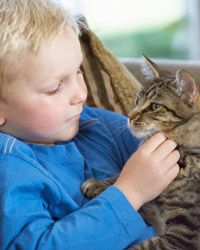The housecat is the most popular pet in the United States, and many cat lovers cite the feline's independent nature as one of the reasons they chose a cat as a pet [source: ASPCA]. Cats are certainly one of the easier pets to care for; they don't require much grooming, take well to litter training and can be left with minimal supervision for extended periods of time as long as there's plenty of fresh water, food and clean litter. Watching a cat's natural behavior can teach children a lot about responsibility, too. It's every parent's goal to raise a self-reliant, dependable child, and your cat can be an excellent teacher and role model. In this article, we'll explore cats' natural behaviors and how caring for one can help instill a strong sense of responsibility in a child.
Advertisement


